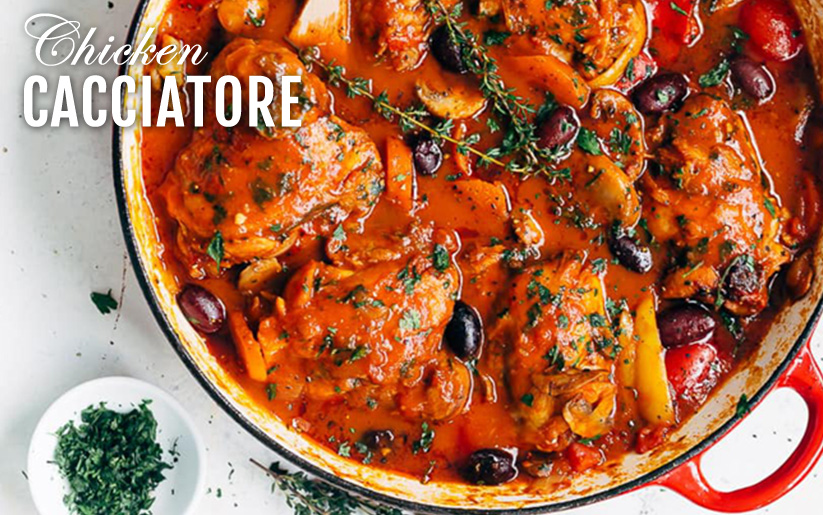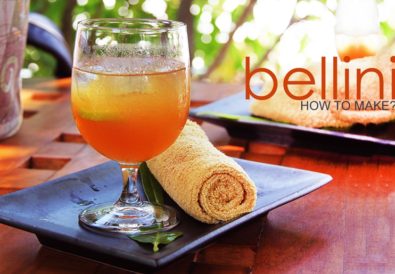
Chicken Cacciatore
This is a more refined and adapted version of chicken cacciatore – an Italian preparation cooked with tomatoes, mushrooms, pancetta, black olives, garlic, herbs, and some wine, of course!
Ingredients
- 8 skinless chicken drumsticks/ thighs – While some recipes call for using skin-on meat, we suggest using skinless cuts of chicken since post browning, it has to be cooked in a sauce (and hence no crisp skin).
- 100 Gm pancetta – chopped
- 200 Gm pack button/ cremini mushrooms – cleaned and sliced (Never wash mushrooms. They absorb water, like a sponge.)
- 1 X 400 Gm can chopped tomatoes
- 200 Gm cherry tomatoes – halved
- 3/4 Cup chicken stock 175ml
- 1 small red bell pepper – chopped
- 1 onion – peeled and chopped, or sliced for a more rustic feel (as per your preference)
- 1 Cup pitted Kalamata olives
- 1 tbsp tomato paste
- 4 garlic cloves – peeled and mince
- 2 sprigs of thyme
- 2 tbsp finely chopped flat-leaf parsley
- 1 tbsp shredded basil leaves
- 1/2 tbsp dried oregano leaves
- 1/2 tbsp chilli flakes
- 3 tbsp olive oil
- Salt and pepper to taste
Instructions
-
Heat a skillet and pour in the olive oil. As it heats, take the cuts of chicken in a bowl and sprinkle with sufficient salt and pepper. Mix with your hands, ensuring that the seasoning is uniformly distributed. Once the oil is hot, increase the flame to medium-high and place the chicken pieces in the pan. A medium-high heat would mean that the pores of the flesh are sealed and the juices retained inside.
-
Check the piece of chicken in the centre of the pan. If the side touching the surface of the pan has golden-browned, flip it over. Brown the meat on all sides and remove with a slotted spoon to a bowl.
-
Reduce the flame to medium and add the pancetta to the same skillet. Cook, stirring a few times until it is golden. Transfer using a slotted spoon to the bowl with the chicken.
-
Continuing to use the same pot, reduce the heat to low setting and tip in the onion. Cook for 5 minutes so that the raw harshness of onion disappears. Add the garlic and cook, stirring, for a minute. Then, tumble the mushrooms and one of the thyme sprigs into the pan. Mix thoroughly. They would soon release their liquid, which would help soften the vegetables. Cook until the pan is dry and then stir in the chopped red pepper. Sauté on medium heat for 30 seconds.
-
Now, lowering the heat to simmer, pour in the Pinot Gris. The wine will ‘deglaze’ the pan and all the flavourful bits sticking to the surface of the pan will come off. Send the browned chicken back into the pan, along with any juices that may have collected in the bowl. Reducing the wine means that this foundation for sauce will absorb all the flavour.
-
Once the white wine has reduced by half, add the tomato paste. Mix so that it coats the chicken. Return most of the sautéed pancetta back to the pan, reserving some for garnish. Then pour in the chopped tomatoes and chicken stock. Add the remaining fresh thyme along with the dry oregano leaves. Cover the lid and cook until the meat is falling off the bone.
-
Finally, add the cherry tomatoes, black olives, basil, red chilli flakes, and half the amount of parsley. Mix and check for seasoning. Remember that the chicken was seasoned before browning. Pancetta has salt too. So does commercially available chicken stock. Kalamata olives contain plenty of salt. Adjust salt and pepper accordingly and cook for another ten minutes. Serve hot, garnished with the remaining pancetta and parsley.
Recipe Notes
1. You can use boneless chicken if you like. Using meat on the bone, however, means additional flavour.
2. You can use crushed tomatoes if you like. It’s interesting how this dish can be made refined, or rustic/ peasant-style, to an extent, by cutting ingredients more or less finely. For greater finesse, use 5 chopped tomatoes instead of canned ones and cook them until they thoroughly melt into the sauce.
3. You don’t have to use extra virgin olive oil for cooking. Reserve it for salads. Go for regular olive oil here.
4. Ensure that the skillet doesn’t get overcrowded while browning the meat, or it would ‘braise’ in its juices instead of frying. You may want to do it in two batches.















